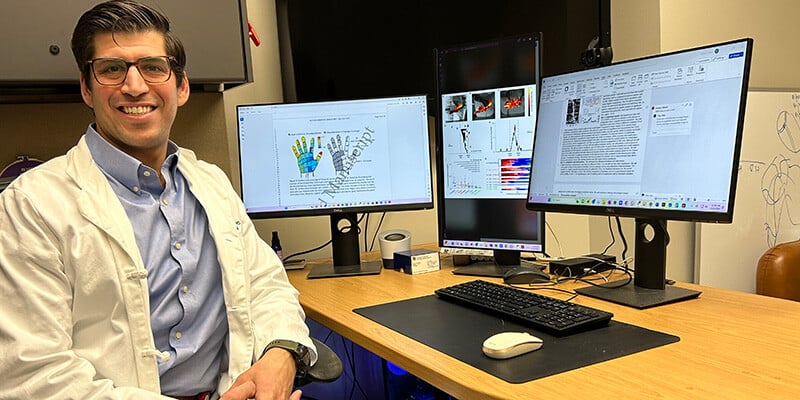Your lab recently received approval to begin recruiting in Colorado for a brain-computer interface study. Tell us about it.
Yes, we just got FDA (Food and Drug Administration) approval to begin chronic recording using brain-computer interface. We’ll be recording signals coming from the brain, and then interpreting them to control external effectors, like a cursor on a computer screen or a complicated robotic arm. We’ll be using something called a Utah Array, which is surgically implanted into the brain tissue of patients with paralysis to record movement and restore functions. It’s a technology that’s been successfully used with patients for 10+ years.
What’s unique about your work at CU Anschutz?
There are two unique features that my lab has that other brain-computer interface labs don’t necessarily have. The first is that our work is somatosensory. We can stimulate both primary sensory areas and higher-order sensory integration areas. We’re able to read the signals coming out of the brain, and we can also stimulate and send sensory information back into the brain. The idea is to restore sensation, for example, in paralyzed individuals with spinal cord injury or ALS.
The second thing that’s unique to this lab is that we're using higher-level cognitive areas. Most of the BCI programs in the country do motor cortex, which is basically the final stop between the movement you want to do and sending the plan down through the spinal cord to the muscles. We’re working with higher-level cognition, which is closer to conscious thought. It’s helping us understand motor planning and how people make decisions about things to do.
What are your goals around restoring sensation?
We can already use touch sensors on, for example, a robotic arm and feed that information back into the person’s nervous system. On the scientific side, we’re trying to recreate more natural sensations. But there’s also the engineering side where we feed information back into the brain. As we reach out and touch something, sensory information comes back. This information tells us things like how much force to use when, say, you grab a glass of water. We’re trying to restore both parts of it by understanding the science and engineering components of it.
Outside of BCI, what else is your lab working on?
We are close to submitting our application for FDA approval to study higher levels of cognition using neuropixels. Neuropixels are electrodes that record neural activity. Neuropixels give us 960 recording channels on a needle shank thinner than a human hair. Our aim is to implant the neuropixels into an area in the prefrontal cortex that's involved in high-level cognition. So it's an area implicated in what we call cognitive control, or executive function. This is where we apply rules and abstract and working memory. For example, when you're thinking about a problem and trying to reason through a problem, you’re using executive function skills.
It’s devastating for individuals to lose executive function due to Alzheimer’s, Parkinson’s or traumatic brain injury. And the problem is, we don't know enough about it to provide any help. It’s very challenging to study in animals due to their limited capacities as compared to human capacity. We’ve studied it in humans using fMRI (functional magnetic resonance imaging), which has gotten us far but still has limitations. For example, an fMRI will show us a bright spot over the course of seconds, but it doesn’t tell us what’s actually going on. By placing these electrodes in the brain tissue, we can see somewhere in the range of 300 simultaneous neurons from a single insertion. We’ll get very high-output data that’s not been possible before. We're going to try to understand how the brain is able to execute extreme neural flexibility.
This sounds like a game-changer.
It is! The fMRIs give us nice information, but it measures blood flow, which is a very indirect measure of neural activity. With neuropixels, we’re directly measuring neural activity. The workhorse of the brain is a neuron, and this technology records 300 neurons. Even in BCI, we’re recording a max of 96 neurons but typically that’s limited to 40 or 50 neurons. And that’s only in the research context.
In a clinical context, we can record somewhere in the range of four or five neurons at the same time. People have written amazing papers doing four or five neurons per recording session per patient at a time. With neuropixels, we're talking about doing 300-plus neurons at the same time. It's an order-of-magnitude difference.
What would you like people to understand about your work?
Just that this is a small area of study with the potential for big impact. My group has been studying this for about a decade, and there are only 20 to 30 patients across the country who have been implanted and studied with BCI. All of the researchers in this area are working toward the same thing, which is sensory-motor restoration. We all have our own slant – from handwriting and speech to higher-level cognitive function – that we’re working on in our group. We’re vastly bringing the field forward. It’s one of the few areas of science where our knowledge is really limited, and I’m excited to move things forward.
Also, we’re actively recruiting tetraplegic individuals for our brain-computer interface study here in the Denver-metro area. If you know of anyone who may be interested, please contact me.
Guest contributor: Carie Behounek is a freelance writer specializing in healthcare and academic medicine.





